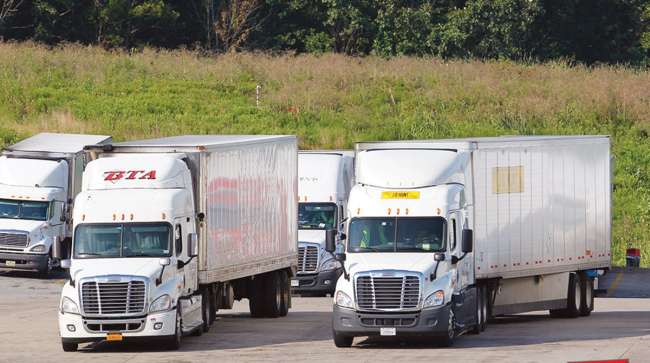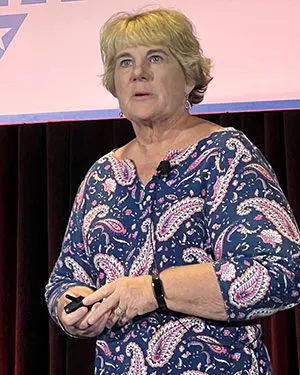Senior Reporter
ATRI Announces Top Five Research Issues for 2023

[Stay on top of transportation news: Get TTNews in your inbox.]
HOLLYWOOD, Fla. — The American Transportation Research Institute unveiled its top five research projects for 2023 at American Trucking Associations’ annual Mid-Year Management Session.
ATRI’s leadership says amid the ongoing issues related to truck parking, its board has approved a study specifically looking at the cost and impact of expanding truck parking facilities at public rest areas as its No. 1 focus
“If states would examine their footprint at public rest stops, it could just be as simple as putting down more pavement at a location where there is already a facility. It’s land that states already own,” ATRI President and chief operating officer Rebecca Brewster told Transport Topics, noting that this expansion could be low-hanging fruit. “Can we add 50 more spaces at an existing rest area, and hopefully this type of study will turn the light on for state DOTs.”
Brewster said previous ATRI studies have found that female drivers prefer parking at publicly owned rest stops because they feel safer and they believe there is more privacy.

ATRI President and CEO Rebecca Brewster. (Dan Ronan/Transport Topics)
“We want to also examine areas where states are thinking outside the box, including permanent weigh stations; there are restroom facilities, they have lighting and these are built for truck parking, so it’s just a logical extension.”
A recent survey conducted by the Federal Highway Administration noted there are 313,000 truck parking spaces nationwide. American Trucking Associations and the Owner-Operator Independent Drivers Association estimate there is one parking spot for every 11 drivers.
“This study will be another tool. Is there adjacent land next to existing rest areas? And can they change some policies to free up some land, to create more spaces for professional truck drivers?” she said.
The second issue that ATRI researchers will tackle concerns finding the barriers for women who are interested in entering the trucking industry.
It it is really identifying those barriers to entry, so we might identify them and find some solutions.
ATRI President and CEO Rebecca Brewster, on easing access for women to enter the trucking industry
“I like the approach to this research, because it will be talking to women who are currently in the industry, but also women who have left the industry and why they choose to leave,” Brewster said. “Was it because of family and child care issues? We’ll look at some best practices from some fleets on that. Is it because they didn’t feel safe, was it the truck parking issue? I think there are a whole host of issues. But it is really identifying those barriers to entry, so we might identify them and find some solutions.”
#ATRI Releases 2023 Research Priorities
Expanding Truck Parking at Public Rest Areas
Identifying Barriers to Entry for Female Truck Drivers
Complete Streets Impact on Freight Mobility
Examining the Diesel Technician Shortage
The Cost of Driver Detention
Read more: — ATRI (@Truck_Research) May 8, 2023
The percentage of women in the trucking industry is increasing, and the advocacy group Women In Trucking Association estimates 13.7% of drivers in 2022 were women. That’s an increase of almost 30% over the 7.9% seen in the WIT Index in 2018. The gain came after an industrywide push to hire more female drivers in response to the capacity crunch in 2018.
The third issue ATRI plans to tackle are the changes taking place and the impacts they may have on freight deliveries as municipalities remove and reroute interstate highways that were often built in minority communities more than half a century ago. One such change is likely to take place in Syracuse, N.Y., as a part of Interstate 81 in downtown is set to be demolished.

This special "Inside the List" episode features the Transport Topics 2023 Top 100 largest logistics companies. Hear the program above and at RoadSigns.TTNews.com.
“We’re seeing proposals in a number of locations to close interstates,” she said. “We still have to have freight delivered and regardless of where you live, freight still needs to be delivered to your grocery store, the local hospital, and if you start closing those interstates, the freight is going to go onto the side streets and your local routes. Do you think citizens are going to like the net result of that? No.”
Brewster said the research will help city planners and others understand how freight is delivered and what the impact could be by shutting down or demolishing those roads.
The fourth area of research concerns the consequences of the ongoing shortage of diesel technicians and what can be done to improve conditions for young men and women who are considering careers in this field, as well as midcareer candidates who may want to start.
“Being a diesel technician today is not what you learned in shop class in the 1950s, ’60s and ’70s,” Brewster emphasized.
Want more news? Listen to today's daily briefing above or go here for more info
According to the TechForce Foundation’s 2022 Transportation Technician Supply & Demand Report, demand for new entrants in the diesel technician field is high, and 177,000 new entrants are needed between 2022 and 2026 from both new demand and existing positions.
The fifth area of research concerns the ongoing issue of the cost of driver detention, where drivers often must sit for hours, sometimes not being paid, while they wait for their trucks to be loaded or unloaded.
“Detention continues to be a top issue on our driver concern list,” Brewster said. “We have had drivers routinely report detention times of six hours, sitting there and not getting paid. This is a retention issue for our industry.”
The ATRI Top 5 List is in addition to the regular research the nonprofit does concerning truck congestion and the cost of operating a truck.




